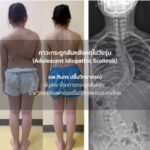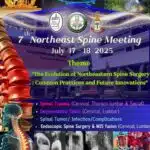Lumbar disc degeneration
(Lumbar Degenerative Disc Disease)
Chapter 2: Diagnosis and treatment
Dr. Chaiyuth Suthirayongprasit
Spine Division, Royal College of Orthopaedic Surgeons of Thailand
How to diagnose this disease?
record
Diagnosing lumbar disc degeneration, the doctor will start by asking about your history of back pain, how long you have had it, if there are other symptoms such as pain radiating down the leg, numbness, fever, or abnormal bowel control, underlying diseases or health conditions, occupation, daily routine, sleep, hobbies, and past injuries or illnesses.
Patients should see a doctor if back pain lasts longer than 2 weeks, does not improve with over-the-counter pain medication, or if the pain is unusually severe even with light movement, or if back pain radiates down the leg or is accompanied by numbness.
Physical examination
After taking a medical history, the doctor will perform a physical examination to determine the overall movement of the spine, whether there are any positions that make the pain worse or less, whether there are any specific areas of pain or abnormalities, and whether there are any abnormalities in the nerves in the spine. These factors may help identify the cause or location of the pain.
Radiological examination
To confirm that there is degeneration of the intervertebral discs, an MRI scan is required, which also helps the doctor to see other abnormalities or pathologies in the spinal structure, such as fractures, collapse, herniated discs, infections, or even cancers that occur in the spine.
Treatment
Once the disease has been diagnosed, the treatment process begins, which includes:
Behavior/Activity Modification
It is very important to reduce or avoid behaviors or activities that trigger back pain, such as sitting for long periods of time or sitting in an improper position, sitting on the floor, crossing your legs, squatting, or crossing your legs, bending over to lift objects, carrying children, or exercising that involves lifting weights, causing a lot of impact, bending, bending, or twisting the body excessively or repeatedly.
Exercise
It is recommended to exercise to strengthen the core muscles of the body, which are the abdominal muscles and back muscles. Exercises to stretch the hip muscles and hamstrings.
Other recommended exercises for back pain patients include swimming, aqua exercises, stationary cycling, walking, and elliptical trainers. Tai Chi, Pilates, and basic yoga can also be done safely.
Use of medicines and medical treatment
Patients may start with basic painkillers, which can be purchased at a pharmacy by a pharmacist. If symptoms do not improve, they should see a doctor, who may consider using stronger painkillers along with anti-inflammatory drugs or other drugs depending on the diagnosis of any underlying diseases. The doctor may also refer the patient for physical therapy in conjunction with medication, or even more complex treatment, such as injecting anti-inflammatory drugs into the spinal canal, etc. This depends on the pathology and response to treatment of each patient.
Physical therapy
Patients may start by themselves, such as applying heat before activities to relax the muscles and applying cold compresses after activities to reduce pain and inflammation.
Formal physical therapy by a physical therapist who will create a program and use specific physical tools for each patient according to the pathology or as ordered by the doctor.
It is recommended to wear a waist-level back brace for a short period of time when there is pain. This will help prevent and reduce pain during posture changes. However, if used continuously for too long, it will cause the back and abdominal muscles to become weak, which is even more not beneficial for degenerative disc disease.
Alternative medicine
Alternative treatments such as massage, acupressure, chiropractic, or acupuncture have been found to relieve back pain through mechanisms that relax tension in the back muscles, depending on the individual patient's response.
Surgical treatment of lumbar disc degeneration
Surgery may be necessary in some patients with degenerative disc disease who have not responded fully to the above-mentioned treatment modalities for at least 6 months to 2 years.
Since most patients generally improve with conservative treatment within the above mentioned time frame,
The standard surgical treatment for degenerative disc herniation involves fusion of the adjacent vertebrae to eliminate the microscopic instability or dislocation that is causing the pain.
For other types of surgery such as artificial disc replacement, more long-term evidence is needed to confirm the results when compared to standard surgery.







